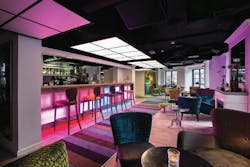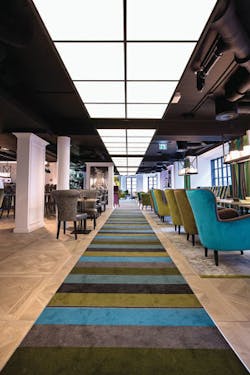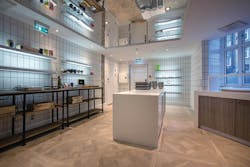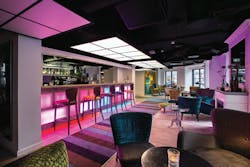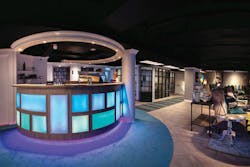Controllable colors and brightness in an intelligent SSL retrofit indoors and out help the Absalon Hotel stand out in Copenhagen’s hip Vesterbro neighborhood, writes MARK HALPER.
When you shut down your faded 76-year-old hotel for six months and spend $15 million converting it into a stylish and trendy destination, you want to make sure that when it reopens, it has all the touches that could make it stand out in a crowded field. For Copenhagen’s family-run Absalon Hotel, the piè;ce de résistance in a chic top-to-bottom refurbishment was a modern, intelligent, indoor and outdoor solid-state lighting (SSL) system that offers a complete range of changeable colors and brightness at the touch of a button, and thus allows the 161-room hotel and its guests to easily alter ambience and suit moods.
Interested in more articles & announcements on LED lighting?
While much of the striking new appearance of the century-old building comes from the fabrics and furniture provided by London design house Designers Guild, make no mistake: The variable and vivid lighting schemes accentuate it and help brand its unique look in a manner that would not have been possible prior to the new era of digitally controlled LED-based lighting.
“We thought the lighting would be a way to differentiate ourselves from our competitors,” said Karen Nedergaard, the hotel’s chief executive, and granddaughter of the 1938 founders who first turned an early 1900s building of small, private apartments into a hotel and named it after the 12th century archbishop who founded Copenhagen. “We live in Denmark, where half of the year it’s very, very dark. We believe that light is one way to lighten up the life and experience of our guests.”
Lighting could also help distinguish the hotel from considerable competition, as Absalon sits in the heart of Copenhagen’s popular Vesterbro district - a former meatpacking and Red Light area that the website Thrillist last year anointed as the fourth “most hipster” neighborhood on the planet.
The pressure was on to find all the right touches. So in October 2014 when Absalon started tearing down walls; opening up the ground floor to view from the outside; upgrading furniture; livening the curtains, carpets, and wallpaper; replacing windows; remodeling bathrooms; cozying up the original entrance and adding a second side doorway for functions; eliminating about 30 rooms; painting; rewiring; replumbing, and generally gussying up the whole place for the first time in decades, lighting was high on the to-do list.
A cue from Hue
Drawing inspiration from Philips’ Hue line of color and scene-changing residential lamps, Nedergaard started inquiring with the Dutch lighting giant about whether it could deploy similar technology on a wider scale across her hotel property. After a trip to Philips’ hospitality industry showcase - one of several industry-specific displays at Philips’ Lighting Application Center in Eindhoven, the Netherlands - she was convinced that it could.
Nedergaard wasted no time placing her order for a variety of lighting systems from top to bottom, both inside and outside the hotel.
Among them: a variable lighting scheme for the hotel’s first-ever bar to accommodate different moods and functions throughout the day and night; soothing green and turquoise desk-front light panels matching Designers Guild furniture in the reception area; color-changing bathroom lights for the premier rooms on the top floor of the five-story hotel; under-bed lighting that clicks on to motion sensors when guests get up in the night; corridor sensors that keep the lights dim until someone walks in; and outdoor façade lighting intended to bathe the building in white light except on special occasions such as recent Christmas celebrations, when the building turned green and red.
LEDs and controls
Absalon also decided on all LED lamps, meant not only to respond colorfully to digital controls where mandated - in a way not possible with conventional lamps - but also to save energy, as LEDs are known to do. Most of it, with the exception of the façade lighting, has worked like a charm since the hotel reopened its doors in May.
One of the key elements to the scheme is the downstairs lighting in the lobby and the bar - all visible from outside, and thus a huge influence on Absalon’s image and even on the bar’s possibilities for drawing in passersby (Fig. 1). Panel lights on the front of the bar desk, as well as ceiling lights in the bar area, respond in color and brightness to one of five pre-programmed scenarios: breakfast, lunch, afternoon, evening, and “bar.”
The bar area leads to the hotel’s breakfast lounge (Absalon does not serve other meals), so in the morning, lights are programmed bright and white (Fig. 2). “It’s lit up so people can find their way to the breakfast restaurant easy and undisturbed,” said Martin Brandt, Absalon’s food and beverage manager. The scheme cycles through five regular pre-programmed changes throughout the day. By evening, the automated system dims the lights, and at around 8 PM, it swings into bar mode, emitting a variety of blues, violets, reds, and greens (Fig. 3).
And with the ground floor now visible from the street, “this light can also help attract people from outside to come in and join the bar,” added Nedergaard.
Push-button scenarios
Although the Philips system in principle could also allow individual employees greater control to order more color schemes, the hotel decided against that. “From an operational point of view, I needed to have something set,” said Nedergaard. “I didn’t want the employees to play with the lights. It’s important to have light that’s aligned - a procedure that’s the same every day at the same time. Otherwise, one comes in and wants it pink; the next one wants it green, the third one wants it yellow. This is not going to work. And I was afraid that the employees would forget to change it in the afternoon. So we just put everything on automatic.”
But employees are able to override the pre-programmed settings and advance them to one of the other five pre-set scenarios. “If we see that there’s a lot of people in the bar, then we could switch on the bar scenario instead of the afternoon scenario,” explained Nedergaard. “It’s just a button that we push, and we can change the scenario.”
The button is on a wall-mounted panel that uses DMX controls tied into a Philips computer system, with signals traveling to lights over electrical cabling, noted Jørgen Bo Jensen, the Philips account manager who has worked closely with Absalon on the project.
Matching interior design
The turquoise and green lobby lighting, while not as controllable as in the bar area, echoes the colors of the Designer Guild interior design, which was all part of Nedergaard’s notion of brightening up the hotel’s look both via lighting and fabric, and to move away from what she noted are typical of Danish hotels: pale white, beige, or black colors (Fig. 4).
“We decided to work with a color palette of green, turquoise colors, in the lobby lounge area,” she said. “We could see how the Philips lighting could complement the colors in the design, and it would all fit together and we were able to create this homey feeling. That’s what we were really after.”
In another touch of non-colored lighting, the hotel suspended panels of stylish floating white lights from the black-painted ceiling on the ground floor to illuminate the path between the reception, bar, and breakfast areas. The panels’ shape echoes the hotel’s windows and helps suggest natural light. They respond to DALI-controlled dimming. Likewise, the hotel dropped floats of LEDs mimicking candlelight in the lobby area, for a cozier look. In the lessons learned department, food and beverage manager Brandt wishes that he could control smaller groups of lights per control panel - a simple electrical issue - but other than that, he reported that the new LED lighting is working brilliantly.
Color, color everywhere
Outside of lighting, the refurbishment called for plenty of color in the Designer Guild fabrics, furnishings, and walls in the guest-room floors, which it designed either in purple for a berry theme; blue and silver for an ocean theme; or pink, green, and black for a grass theme, varying by floor. That’s one reason why Nedergaard opted against offering colored lighting in the rooms and in the reception area - it would be overkill among the splashy fabrics. “It’s not necessary to bring in colored lights in the rooms,” Nedergaard said.
But Absalon did equip the marble-walled fifth-floor bathrooms so guests can cycle ceiling spots through the color spectrum. It also outfitted them with adjustable white light by the makeup mirror that ranges from 2700K to 6500K in CCT, according to Philips’ Jensen.
The hotel refrained from installing changeable colors in the bathrooms on other floors. Part of the reason was cost. “At one stage in a big renovation you have to say stop,” noted Nedergaard, who said it’s possible the hotel might eventually install the colored bathroom lighting on other floors. She described the lighting in its entirety as costing “a lot of money.” Philips’ Jensen estimates that lighting in total accounted for about 2.5 million Danish kroner (about $367,000) of the $15 million renovation.
The hotel also decided not to give guests app-based smartphone control of light. “We thought about this, but we thought it was going to be a bit too complicated for the guests,” explained Nedergaard.
LEDs everywhere
One technology consistent throughout the hotel, whether it’s public spaces, rooms, or the exterior façade, is LED sources.
The rooms have on average two reading lamps, two bedside lamps, a table lamp, the under-bed lighting, LED strips in portions of wall moulding to softly illuminate the ceiling, and four to six spots in the bathroom. Between these and the sensor-activated corridor LEDs and the other systems, Nedergaard expects to achieve energy savings, because LEDs are known to drastically reduce electricity consumption by around 90% over conventional incandescent lighting.
The hotel also installed sensors to switch off lights in staff and housekeeping rooms. “Everywhere we saw the lights were always on, we put the sensors,” said Nedergaard. Although she claimed it’s too early to ascertain the actual energy reduction, Philips’ Jensen expects that it will be around 60% - and that’s with a lot more lighting products and illumination options than the hotel previously had.
Jensen added that the LED lamps will also cut maintenance costs, given their expected longevity of 20 years or more. “They have this maintenance guy, and he’s being freed to do a lot of other things, because before he spent a lot of time going around with his little basket changing bulbs every day at the hotel,” said Jensen.
But Nedergaard noted that the maintenance story isn’t quite as rosy as often portrayed for LEDs, because the bulbs are fragile and can fail when accidentally jostled. It’s not unusual for an LED lamp to simply stop working in guest rooms. “Some of them, if you hit them, they can go out,” said Nedergaard. The same is true for ground-floor lamps that the hotel sometimes raises when it moves the tables for events so people don’t walk into them. The lifting and lowering can knock them out because “they are very sensitive to movement,” she noted, adding that it happens with both Philips and Osram replacement bulbs.
Disco inferno
But whatever problems Absalon is having with fragile indoor LED lamps pale in comparison to the one clunker in the hotel’s lighting redesign - the exterior façade, equipped with a Philips DMX-controlled Color Kinetics system. (See our feature on the LightRails project, which also implemented Color Kinetics products.)
“We had a little dispute over the façade lighting,” said Jensen. “The white light is not good enough.” That’s one way of putting it. “The problem is the white light is too many colors - it’s every color of the rainbow,” added hotel boss Nedergaard. “Somewhere, it went wrong.”
The façade system has been troubled from the start. When the hotel first switched it on in May, “the lights were doing a lot of disco dancing,” recalled Nedergaard, noting that not only was that unsuitable for the hotel’s purposes, but it was also a nuisance for neighbors. “So we decided to wait until it was working properly.”
Long months of difficult testing followed, as extended summer daylight set in and testing often had to take place after midnight in order to see nighttime effects. When the hotel finally switched the façade lights back on in November, it discovered they were full of too many colors in white mode.
That hasn’t stopped the hotel from providing special illumination effects such as the green and red façade for Christmas. But it is hoping that Philips resolves the white lighting soon. “This is something that we’re discussing with them,” said Nedergaard.
Meanwhile, Nedergaard is coloring the indoor digital lighting systems as a success. Hipster, hipster hooray!
MARK HALPERis a contributing editor with LEDs Magazine ([email protected]).
